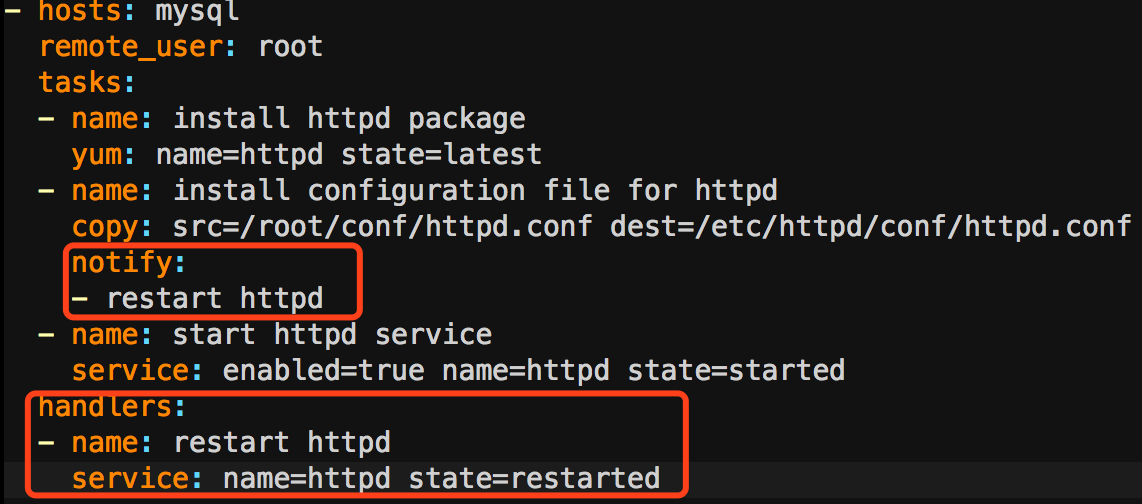ansible入门四(Ansible playbook基础组件介绍)
本节内容:
- ansible playbook介绍
- ansible playbook基础组件
- playbook中使用变量
一、ansible playbook介绍
playbook是由一个或多个“play”组成的列表(剧本是由多出戏组成的)。play的主要功能在于将事先归并为一组的主机装扮成事先通过ansible中的task定义好的角色。从根本上来讲,所谓task无非是调用ansible的一个module。将多个play组织在一个playbook中,即可以让它们联同起来按事先编排的机制同唱一台大戏。下面是一个简单示例。
- hosts: webnodes
vars:
http_port: 80
max_clients: 256
remote_user: root
tasks:
- name: ensure apache is at the latest version
yum: name=httpd state=latest
- name: ensure apache is running
service: name=httpd state=started
handlers:
- name: restart apache
service: name=httpd state=restarted
其中,tasks是一个一个任务。
二、ansible playbook基础组件
Playbooks结构:
- Tasks:任务,即调用模块完成的某操作。
- Variables:变量
- Templates:模板
- Handlers:处理器,指的是在某条件满足时能够触发完成的功能,或者说是由某事件触发执行的操作
- Roles:角色。
1. Hosts和Users
playbook中的每一个play的目的都是为了让某个或某些主机以某个指定的用户身份执行任务。hosts用于指定要执行指定任务的主机,其可以是一个或多个由冒号分隔主机组;remote_user则用于指定远程主机上的执行任务的用户。如上面示例中的
- hosts: webnodes remote_user: root
不过,remote_user也可用于各task中。也可以通过指定其通过sudo的方式在远程主机上执行任务,其可用于play全局或某任务;此外,甚至可以在sudo时使用sudo_user指定sudo时切换的用户。
- hosts: webnodes
remote_user: mageedu
tasks:
- name: test connection
ping:
remote_user: mageedu
sudo: yes
比如写一个最简单的playbook,里面写了两个play,一个play是在nginx组的主机上都创建一个nginx组,nginx用户,另一个play是复制一个文件到mysql组的主机上:
[root@node1 ~]# vim nginx.yml
- hosts: nginx
remote_user: root
tasks:
- name: create nginx group
group: name=nginx system=yes gid=208
- name: create nginx user
user: name=nginx uid=208 group=nginx system=yes
- hosts: mysql
remote_user: root
tasks:
- name: copy file to mysql hosts
copy: src=/etc/inittab dest=/tmp/inittab.ans
查看ansible-playbook的使用方法:
[root@node1 ~]# man ansible-playbook
运行playbook:
[root@node1 ~]# ansible-playbook nginx.yml

2. 任务列表(Tasks)和action
play的主体部分是task list。task list中的各任务按次序逐个在hosts中指定的所有主机上执行,即在所有主机上完成第一个任务后再开始第二个。在运行自下而下某playbook时,如果中途发生错误,所有已执行任务都可能回滚,因此,在更正playbook后重新执行一次即可。(因为具有幂等性)
task的目的是使用指定的参数执行模块,而在模块参数中可以使用变量。模块执行是幂等的,这意味着多次执行是安全的,因为其结果均一致。
每个task都应该有其name,用于playbook的执行结果输出,建议其内容尽可能清晰地描述任务执行步骤。如果未提供name,则action的结果将用于输出。
定义task的可以使用“action: module options”(这个在较新版本上才能执行)或“module: options”的格式,推荐使用后者以实现向后兼容。如果action一行的内容过多,也可以使用在行首使用几个空白字符进行换行。
tasks: - name: make sure apache is running service: name=httpd state=running
在众多模块中,只有command和shell模块仅需要给定一个列表而无需使用“key=value”格式,例如:
tasks: - name: disable selinux command: /sbin/setenforce 0
如果命令或脚本的退出码不为零,可能会阻止playbook继续往下执行可以使用如下方式替代:
tasks: - name: run this command and ignore the result shell: /usr/bin/somecommand || /bin/true
也就是说这个命令失败也是要继续往下走的,就是失败了但不要影响下面的操作。或者使用ignore_errors来忽略错误信息:
tasks: - name: run this command and ignore the result shell: /usr/bin/somecommand ignore_errors: True
3. handlers
用于当关注的资源发生变化时采取一定的操作。
“notify”这个action可用于在每个play的最后被触发,这样可以避免多次有改变发生时每次都执行指定的操作,取而代之,仅在所有的变化发生完成后一次性地执行指定操作。在notify中列出的操作称为handler,也即notify中调用handler中定义的操作。
- name: template configuration file template: src=template.j2 dest=/etc/foo.conf notify: - restart memcached - restart apache
handler是task列表,这些task与前述的task并没有本质上的不同。
handlers: - name: restart memcached service: name=memcached state=restarted - name: restart apache service: name=apache state=restarted
【举例】:比如有个配置apache的playbook,然后利用这个来说明handlers。
1.先创建一个apache.yml,里面定义play安装启动apache
[root@node1 ~]# vim apache.yml
- hosts: mysql
remote_user: root
tasks:
- name: install httpd package
yum: name=httpd state=latest
- name: install configuration file for httpd
copy: src=/root/conf/httpd.conf dest=/etc/httpd/conf/httpd.conf
- name: start httpd service
service: enabled=true name=httpd state=started
[root@node1 ~]# ansible-playbook apache.yml
2.假如说某个时刻httpd.conf发生改变了,比如说不再监听在80,而是监听在8080端口,其他没变。修改/root/conf/httpd.conf,把端口改成8080,再执行这个playbook:
[root@node1 ~]# ansible-playbook apache.yml
到mysql组所在的主机172.16.7.153上查看端口,发现监听端口仍然是80:
[root@node3 ~]# ss -tnlp

3.一个程序的配置文件发生了改变,那么程序应该重读配置文件才对。然而默认情况下,你多次唱同一个剧本,如果那个task此前执行过,为了保证幂等性,它是不会再被执行。handlers就是为了解决这种问题而生的。Handlers也是任务,但它不是上来就执行的,只有某个条件满足时才会执行。所以我们去修改apache.yml:
- hosts: mysql
remote_user: root
tasks:
- name: install httpd package
yum: name=httpd state=latest
- name: install configuration file for httpd
copy: src=/root/conf/httpd.conf dest=/etc/httpd/conf/httpd.conf
notify:
- restart httpd
- name: start httpd service
service: enabled=true name=httpd state=started
handlers:
- name: restart httpd
service: name=httpd state=restarted

修改/root/conf/httpd.conf,把端口改成8090,再执行这个playbook:
[root@node1 ~]# ansible-playbook apache.yml

到mysql组所在的主机172.16.7.153上查看端口,发现监听端口改变了,变成了8090:

三、playbook中使用变量
- hosts: mysql
remote_user: root
vars:
- package: httpd
tasks:
- name: install httpd package
yum: name={{ package }} state=latest
- name: install configuration file for httpd
copy: src=/root/conf/httpd.conf dest=/etc/httpd/conf/httpd.conf
notify:
- restart httpd
- name: start httpd service
service: enabled=true name=httpd state=started
handlers:
- name: restart httpd
service: name=httpd state=restarted
【注意】:playbook中能使用的变量不仅仅是这里定义的变量,而是可以使用ansible中定义的所有变量。例如:
[root@node1 ~]# ansible 172.16.7.152 -m setup

另外,在inventory中定义的变量也可以在playbook中调用。例如:
[root@node1 ~]# vim /etc/ansible/hosts




【推荐】还在用 ECharts 开发大屏?试试这款永久免费的开源 BI 工具!
【推荐】国内首个AI IDE,深度理解中文开发场景,立即下载体验Trae
【推荐】编程新体验,更懂你的AI,立即体验豆包MarsCode编程助手
【推荐】轻量又高性能的 SSH 工具 IShell:AI 加持,快人一步